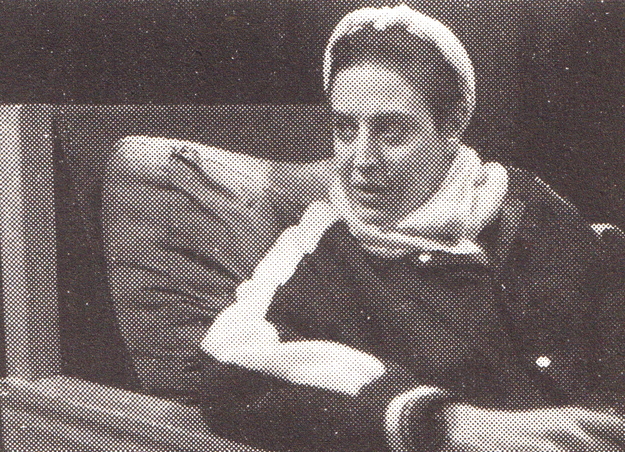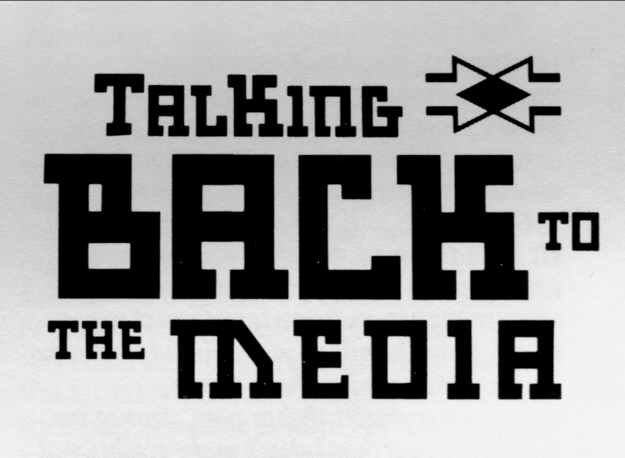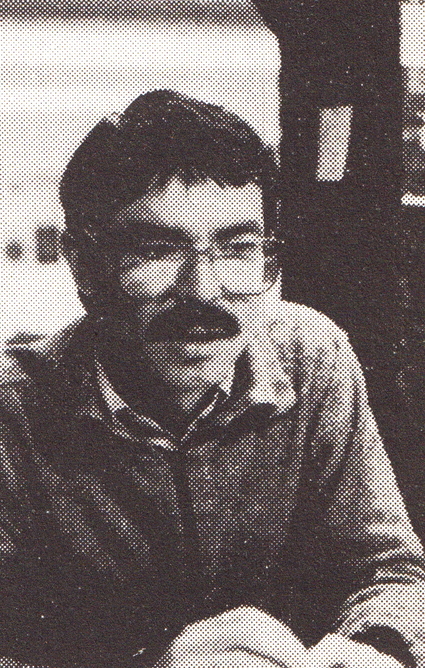It was on the Keizersgracht, near the Leidsestraat, late one evening in Amsterdam, that David Garcia and Raul Marroquin while on their way home started a conversation about Dara Birnbaum.
In those days, some two years ago, Birnbaum was showing videotapes at the Stedelijk Museum in which she used images taken directly from television. Garcia was slightly upset about the prevailing idea that this appropriation of found material from the media was something typically American. It seemed the usual thing was happening again: that the Americans were seen as the initiators of a working-method that had been used in Europe for quite some time.
Raul agreed; But in the States there are more opportunities for artists to show such work. There they have been able to create outlets outside of the established art circuit. In Europe there is no such thing.
Thus the idea arose to show from a European perspective how artists approach mass communications and the mass media.
The two video artists hurried on to David's place to develop this fresh idea. further. Why did they want this?
There is another interesting thing, David said after they had made themselves comfortable, Which is the fact that the Americans have got an entirely different approach to dealing with the mass media than the Europeans. I always think that American and Canadian artists tend to be very literal about the media and present things much more as they are, without commentary and allow you to draw your own conclusions, while work of, for instance, Klaus vom Bruch, Lydia Schouten and of us have got this sort of metaphorical approach to the media. Now, wouldn't it be interesting, he added, to see the two different approaches together in a festival?
Raul jumped up. Suddenly he could visualize it: different approaches, o.k., but he wanted more: a huge manifestation, that would show that artists could certainly cope with the complex mass media apparatus. Wouldn't it be fantastic to gain entry to media and facilities that are otherwise virtually unattainable?
We have to create new channels to communicate our work, he said, which for me is one of the functions of an artist. I think it is of great importance for artists who are working with mass communication tools to come out of the conventional artpodia. He was thinking of the museums and galleries where he and his colleagues regularly presented their new tapes and installations. Of course, that was fine too, but you had to conform, like making a costume to fit your ideas into, in order to make them suitable for the museum.
It is important to see that we're not living in an industrial society anymore, we are living in an information society, and that this is affecting our work as artists too. The ‘art-establishment’ is not prepared for that, they still look upon art much the same way they did the nineteenth century. The media we use, the way we work are considered not kosher because a videotape isn’t an art commodity, that you can show off with. The art market, the collectors are not prepared to accept work that is not done by an individual, or that is not an original in the traditional sense. Imagine, I had someone lately who asked me for an original signed video-tape!
You know, David said after some time, I feel that the appropriate thing to do is to make work which is responsive to the environment that you're living in. It's just automatic: I want to make work about the way I live and where I live. I tend to actually see the realm of the imagination, which includes the mass media, as a landscape which you can inhabit and walk through. It 's got a presence which is as real as the presence of rocks and trees, it's a landscape that influences human behavior just like the ordinary landscape does.
From an easy chair softly came the voice of Annie Wright, David's artistic partner: It's not a landscape, it's a jungle. Landscape is too tame.
You're right, David replied, It's a jungle of images that surround us; posters, shop-windows, sound, and naturally television, radio, papers and magazines too. You shouldn't separate them too much, it’s really like a jungle full of strange plants. Some will bite your leg off, grumbled Annie, That's what makes it so fascinating.
Raul was following his own thoughts. David's landscape was o.k. to him, but he tended to envisage it more in terms of a network. A global network of information and media,which was only waiting for the appropriate impulse to become a global multimedia work of art. The tools were there, it was just a matter of using them. When we are using those new tools, we have to look for new ways to employ them too; you cannot work with video like you'd be working with painting, a camera is not a brush. Exactly! responded David excitedly, You're saying that we should look for new podia to present our work, and of course we should, but I think it's also interesting for us as artists. I mean, I'm extremely curious to see what happens If we actually put our work back into this stream of mass media from which it originates, and see what kinds of strange frictions would occur.
It gradually became clear to David what, to him, was so fascinating about this whole idea of a media- festival; the principal aim for him was not to reach hundreds of thousands of people. Of course, that would be nice, but his motivation was a more personal one, if not rather selfish. He wanted to see what his work would look like when shown in the context of the mass media instead of the intimacy of a video presentation. Whether it would affect his work, or whether the work could fractionally disturb the stream of everyday images.
So, alright, he said, I'm influenced by this media landscape, so let's try and radically create a counter-environment, based on the same principles of chaos and abundance as the media and somehow turn the wheel in a more dramatic way!
David 's stream of thoughts was interrupted by a short ring of the doorbell announcing a visitor. He opened the door and invited the guest in. It was Ulises Carrion.
The others quickly informed him of their plans for a large-scale media art festival. And so it seems tome worth doing together, concluded David, If it was only me putting my own things back into the context of the mass media, that would have a very minimal effect, but if a number of artists who are working in this way would manage to co-ordinate it and at the same time, in the same city create a media-environment!
This would seem to me the most exciting thing to do, he continued enthusiastically, Let's try and affect the whole city, and actually use all the various media: television, posters, shop-windows, publications, radio, exhibitions, stickers, everything! Putting our work back into the media landscape also implies organizing this whole manifestation as a multi-media campaign. Just like when you introduce a new product on the market, it includes an entire media-mix to advertise it as broadly as possible. We should make people as aware of that as possible.
While David unfolded his dreams, Ulises had seated himself near the TV -set and searched the channels for an old B film. He didn't however find anything except the German national anthem. It was getting late.
Before we go on, he said as he turned the sound down, there is something else which is of the utmost importance to me, and that is the aspect of organization.
That's obvious, Raul interrupted, We should organize this manifestation perfectly, it must become a purely professional thing! But that can be arranged. I know a lot of professional people who are willing to co-operate for free ...
Of course it will have to look professional, Ulises resumed, but that was not what I wanted to say. I always believed that organization is an important formal aspect in art. For a hundred years already art is no longer a matter of making things, autonomous objects. It has been clear to me for a long time that I don't make traditional works of art, but processes. The work of art is the entire process, the organization of a channel to present anything to the public in a certain context and not just that what people can actually see in a certain place.
The work of art, in this case is the festival that we are planning, because it is the festival that addresses the public. The work of art isn 't my tape, or yours, the actual work of art is the manifestation.
That was also my original impulse, David said, glancing up surprisedly, to make a festival that could function as a work of art in itself. But obviously it will evolve into a situation where other people will come into it. So then it isn't just a work of art anymore because it won't be just artists who are working on this project.
I look upon it as a piece of art, Ulises insisted, such a complex and heterogenous one that it will be hard to describe, that's what I like about it. I accept the risk of playing a very tiny part in this whole machinery, without knowing exactly to what extent I am participating, how far I master the channel.

Raul shook his head; I don't consider the manifestation as a work of art. The tapes, the photographs, the posters, those will be the works of art, not the manifestation. For me the important thing will not be the festival itself, that will end after say a month, but that many projects will develop from that moment on, that the manifestation will serve as a springboard for the development of a programming of artists in the mass media. That we can go further, not only with cable, but via networks, satellite, whatever!
If you are working with these media, you can limit yourself and say: 'I'm an artist, I don't know anything about, for instance, budgeting'. But I think that you will have to be very aware of these things if you want to penetrate this media scene. We have to confront the media and those who are controlling it.
Ulises thought that Raul was concerned too much about the technical conditions; The problem is not only to gain access to the mass media, he said, but above all: how to make my own media.
Sure, Raul replied, The cable is such a possibility and it's very young in Holland. In New York I can go and cablecast a program for a week if I want to. The audience won't be as large as that of ABC or NBC, but still, I can develop my own audience and that's what is important. So in Holland, instead of letting cable become another tool of the networks, it should be developed in many different ways. And we could also be a part of that and make our own media.
Television, for me, is a model, Ulises went on, it partly determines my activities, I partly copy it's processes and so my work is principally suitable for universal distribution. In practice, that does not happen, but why should I care as an artist? You can't just stop all your activities and wait until you're allowed to broadcast on television! That does not work, for all kinds of historical, social and political reasons, but why bother? I'm prepared to create a model. I am not prepared to put my energy in controlling If it really comes about.
Ulises stretched his arms in a gesture of reassignment. He stood up and put on his coat. All right, it's very late, so I'm going to sleep, Ciao!
Ciao!, Bye!, The others greeted him and took up the thread of their conversation again.
It was already broad daylight when Raul and David parted. Tomorrow they would contact others, discuss the idea further and hear new ideas. It had to become a project in which all the participants would be able to express and formulate their fascination with art and the mass media: A many sided but coherent festival that would capture Amsterdam for a month.
Raul thought it the right moment for a change: Narrowcasting instead of broadcasting, he said in the doorway, with broadcasting via networks your input is in a certain way anonymous. Anonymity is inherent in broadcasting. If you look upon it in the context of 'narrowcasting', however, it is different; If you channel your ideas in very specific ways you can still keep your identity as an artist. Via cable you can address yourself to very specific groups, to neighborhoods, to art lovers.
That day David dreamt of a landscape, stranger than he could imagine: I pictured myself walking in the streets, surrounded by a continual assault of images. I saw myself swimming in a stream of images, television images, posters, neon signs, glittering shop windows. I thought: 'The media are all pervasive and ubiquitous, they are there all the time.' This was all our work was about, and wouldn't it be wonderful If it could be looked at in the context of a city, rather than a museum or a gallery?
All this seemed to him interesting enough for a festival.
If you'd like to quote something: Bruinsma, Max. "Talks on Talking Back." Mediamatic Magazine vol. 0 # 0 (1985)
Translation: Michael Gibbs

